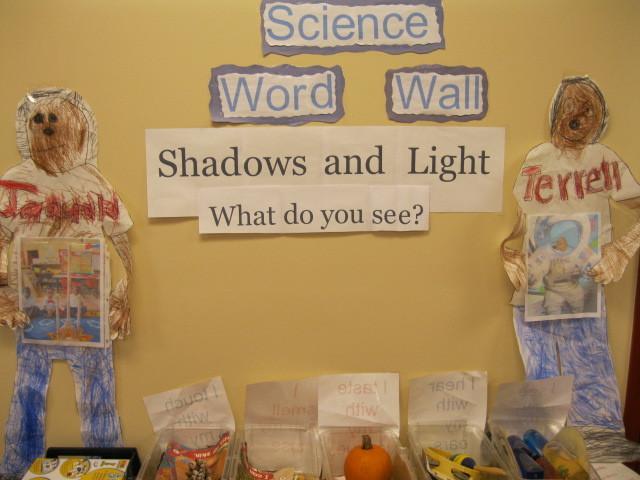Getting Ready: Developing an Inquiry-Rich Environment
Where to begin? Inquiry begins with careful and deliberate planning. Beginning each new science inquiry exploration is an opportunity to provide new materials, inspiration and connections for your students.
Classroom Environment
Space Available
Be sure to provide plenty of open space for explorations. This may mean that only a few children at a time can explore in a space. Try using table-tops for exploration to maximize space in your classroom.
Inspiration and Displays of Student Learning
It is so important to create an environment for students to find inspiration. Posting displays of their own art work, charts, or photographs will help instill confidence in young learners while helping them make their learning more visible.
Students may also be inspired by going beyond the classroom. Take a walk with your students and point out different things connected with their science learning objectives.
This image illustrates a great way to create an inquiry-rich environment in your classroom. This teacher is working on integrating her science topic of Shadows with the class's study of the Five Senses. Notice the use of students' pictures and science work. How would you create your own Science Word Wall?
Science is Everywhere
Themed centers are a crucial component to your classroom environment. But science does not have ot stay in one center! Centers are a great way to integrate investigation and problem solving with literacy, math, art and even social-emotional development. Take some time to tease out the science in each of these areas and offer guidance along the way.
-
Add some books in the reading corner that are about the science subject your students are beginning to explore
-
Put up images of buildings and other structures in the block area for students to find inspiration.
-
Have students cook or wash dishes in the dramatic play area. Offer appropriate tools in the sink for science learning objectives.
Collect and Prepare Materials
When you hear science, you may think that you will have to purchase all kinds of new materials. But in Science in Pre-K, our lessons are explored through real life. The materials that we encourage you to use are everyday objects, and even recycled materials. For tips on getting resourceful with your materials, click here.
Your turn!
Explore the materials you pull together before introducting them to your students. Build a tall tower. Make a shadow change its size. Drop a penny in water. Now an apple. What do you notice when you explore the materials? What kinds of questions do you have? Exploring your materials will not only get you prepared for your students' questions but you may be surprised by some of the science lessons you will learn first-hand!
Getting Ready for your students
Be mindful of the materials you provide. If you are providing materials that may be new to young children, introduce the materials to them during a Science Talk.
Some things to keep in mind about your materials:
-
Are they child-friendly?
-
Are they interesting?
-
Will they be accessible to the children?
-
Are there enough to explore, but not too many to be overwhelming? You can always, and should, switch out the materials to keep students engaged.
-
Are they appropriate for the science content? If students are learning about water for the first time, introducing simple cups, spoons, and funnels may be just enough to get them curious.
Planning for Inquiry
Inquiry science is flexible enough to look different from classroom to classroom, as long as there are plenty of opportunities for students to explore, reflect, and continue to deepen their explorations. While exploration and reflection do not require specific rules, establishing rules, or guidelines, for exploring materials and working together is a great way to help students stay focused and get the most out of their experiences.
Family Connections
Inquiry science offers many opportunities to involve families in your classroom. Seek opportunities to include parents on field trips, science talks, neighborhood walks, or shadow puppet theater shows, outdoor water days, or indoor family science coffee before school. Be creative and work with your fellow teachers - the sky is the limit



